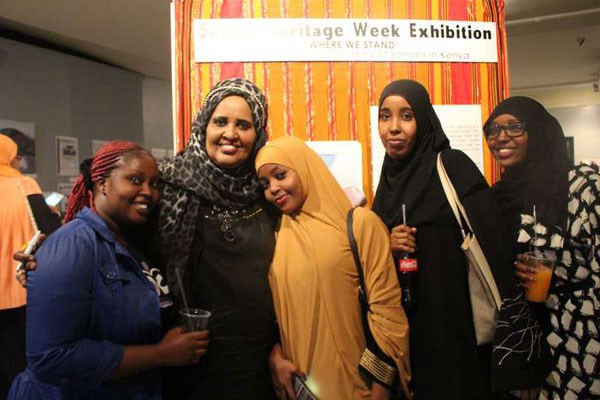
Friday November 27, 2015
By Margaretta Wa Gacheru

Mama Fardousa Jama (2nd L) with Somali youth at Where we Stand exhibition held at the National Museum.
One woman’s hope to change people’s perspective of Somalis and highlight the many positive features of the culture gave birth to the Somali Heritage Week. Writes Margaretta wa Gacheru.
For Fardousa Jama, the Somali Heritage Week which was held last week at the Nairobi National Museum was a dream come true.
“I’d always wanted the Somali community to come together so we could celebrate our common heritage and talk about issues that concern us all,” said the founder of the Awjaama Omar Cultural Research & Reading Centre in Eastleigh.
Ever since she started the Centre in 2013, Fardousa had tried to enlist support for her dream, but it wasn’t until she met Nanjala Njabola from the Heinrich Boell Foundation that it began to take a tangible form.
“I just helped Fardousa organise the Somali Week by handling logistics and fundraising,” says Nanjala who got a slew of donors to support the event, including the Swiss, French and German governments as well as human rights groups like Oxfam, Amnesty International, World Vision and of course, HBS, National Museums of Kenya and Fardousa’s Somali cultural centre.
“But I left the content up to the Somali community itself,” said Nanjala who’s only been working with HBS since June.
“My interest is more related to politics while hers is more cultural so we decided to try combining the two,” said Nanjala who was delighted with the public turn-out made up of mainly Somali-Kenyans of all ages.
They came for cultural sessions that ranged from storytelling, poetry, dance, religion, gender debates, fashion and the actual construction of a traditional Somali hut or Waab.
But they also filled the Louis Leakey Auditorium to listen to political panelists who addressed sensitive topics like; “The security question, Northeastern Kenya in Crisis, extreme radicalisation and the Government’s approach to ethnic diversity.
There was also an interesting conversation on the current condition of the Somali People.
There was also a fascinating panel on “Financial innovation and regional impact” which focused on one of the booming Somali-based businesses; money-transfer.
The one event that combined both politics and culture was the Thursday night exhibition “Where We Stand” which was followed by Judy Kibinge’s powerful film documentary on “The Wagalla Massacre.”
A central feature of “Where We Stand” was a series of striking photographs by Somali-Kenyan youth who launched an online campaign in 2013 following the crackdown on the Somali community in Eastleigh by Kenyan security forces after the Westgate Mall terror attack.
INCREDIBLY SENSITIVE TOPIC
The crackdown continues to be an incredibly sensitive topic among Kenyan Somalis since what they see as “ethnic profiling” didn’t stop even with all security operations that saw many holded up at the Moi International Sports Center which many called a concentration camp.
“@Kenya.IAmNotATerrorist” took social media in Kenya by storm as one could see from the photographs of Kenyan youth holding signs that read; “Eastleigh isn’t a refugee camp nor a terrorist haven. It’s an area resided [sic] by peace-loving and hard-working people” and “I was born in Embakasi. How come I’m not a Kenyan?”
The campaign’s photos conveyed outspoken messages that essentially summarised many of the grievances that Kenyan-Somalis feel, especially related to the ethnical profiling.
“Where We Stand” also featured archival newspaper clips highlighting the recent history of Somalis in Kenya, photos taken in Eastleigh by professional photographers like Boniface Mwangi and Georgina Goodwin, and fine art by Deka Abshir, whose paintings effectively illustrated the underlying rationale for Fardousa’s wanting to launch the Somali Heritage Week in the first place.
“The Somali community in Kenya has unfortunately been fragmented and I’ve tried to illustrate that problem using the symbol of the traditional Somali hut or home, known in our language as a ‘Waab’,” said Deka who studied art in Nairobi at Braeburn and ISK before proceeding the Hunter College in New York, USA where she majored in Fine Art and Women’s Studies.
“The original meaning of the waab has been distorted over time such that organisations like UNHCR have taken the waab as the standard shape of tents that they provide in the [refugee] camps,” added Deka whose images of waabs are segmented into separate canvases that have to be pieced together like a puzzle in order to see the hut in its wholeness.
“It’s that sense of unity that we want the Somali Heritage Week to strengthen,” said Fardousa who ensured the subject of “a Somali identity” was a topic discussed several times in the week.
It was a controversial subject since some Somalis see themselves as Kenyans of Somali extractions. These include a number of prominent people such as the Foreign Affairs Cabinet Secretary Amina Mohamed, the Majority Leader of the National Assembly Aden Bare Duale and the Chairman of the Kenya Independent Electoral and Boundaries Commission Ahmed Issack Hassan to name just a few.
Nonetheless, a number of audience members said emphatically that they identified strictly as Somalis stuck in the country as a consequence of decades of war in their homeland.
Watching Judy Kibinge’s painfully powerful doc-film on The Wagalla Massacre of 1984 reveals the shocking, senseless and sadistic cruelty of security forces towards Somalis living in a remote corner of the country.
It also showed implicitly why an event like the Somali Heritage Week needs to be an annual event where the community can come together and also share their feelings with fellow Kenyans.
“Ultimately, we hope to change people’s perspective of Somalis, which is why we wanted to highlight so many positive features of our culture,” said Fardousa who hopes the Somali Heritage Week will become an annual event attracting not only Somalis but a cross-sections of Kenyans.